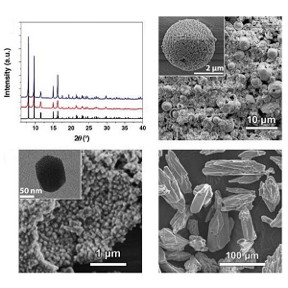Home > Press > Lanthanide-Organic Framework Nanothermometers Prepared by Spray-Drying
 |
Abstract:
A work in Advanced Functional Materials shows how spray-drying prepared MOF nanoparticles containing lanthanide metals may be used as nanothermometers operative over a wide range of temperatures, in particular, in the cryogenic range. The work was coordinated from the University of Aveiro (Portugal) and participated by Ramón y Cajal Researcher Dr Inhar Imaz and ICREA Research Prof Daniel Maspoch from the ICN2 Supramolecular NanoChemistry & Materials Group.
Lanthanide-Organic Framework Nanothermometers Prepared by Spray-Drying
Bellaterra, Spain | Posted on April 16th, 2015Members of the ICN2 have collaborated in a new research to get nanothermometersthat can provide accurate, noninvasive and self-referenced temperature measurements at the submicrometer scale. Ramón y Cajal Researcher Dr. Inhar Imaz and ICREA Research Prof Daniel Maspoch from the Supramolecular NanoChemistry & Materials Group have participated in the research which has been coordinated from University of Aveiro (Portugal). The results have been published in Advanced Functional Materials in an article entitled Lanthanide-Organic Framework Nanothermometers Prepared by Spray-Drying.
The thermal dependence of the phosphor's luminescence provides high detection sensitivity and spatial resolution with short acquisition times in, e.g., biological fl uids, strong electromagnetic
fields, and fast-moving objects.
The strategy followed to design this kind of devices relies on the thermal dependence of the phosphor luminescence, which provides high detection sensitivity and special resolution with short acquisition times in, e.g., biological fluids, strong electromagnetic fields, and fast-moving objects.
The temperature determination is usually based on the change of the luminescence intensity or decay times. However, the measurements based on a single f-f transition may be much affected by the variation of the sensor concentration and the drift of the optoelectronic systems, namely, the excitation sources and detectors. Recently, authors reported self-reference nanothermometers based on the intensity ratio of two f-f transitions that overcome the drawbacks of temperature determination with a single transition.
The article also shows that spray-drying prepared MOF nanoparticles may be used as ratiometric luminescent nanothermometers operative over a wide range of temperatures, in particular, in the cryogenic range. Prof Maspoch and Dr Imaz have contributed in the synthesis of the MOF nanoparticles of Tb(III) and Eu(III), the first lanthanide-organic framework prepared by the spray-drying method. This system is the most sensitive cryogenic nanothermometer reported so far, combining high sensitivity, reproducibility, and low-temperature uncertainty.
Article Reference
Wang, Z., Ananias, D., Carné-Sánchez, A., Brites, C. D. S., Imaz, I., Maspoch, D., Rocha, J. and Carlos, L. D. (2015), Lanthanide-Organic Framework Nanothermometers Prepared by Spray-Drying. Adv. Funct. Mater.. doi: 10.1002/adfm.201500518
####
For more information, please click here
Contacts:
Alicia Labian
Copyright © ICN2
If you have a comment, please Contact us.Issuers of news releases, not 7th Wave, Inc. or Nanotechnology Now, are solely responsible for the accuracy of the content.
| Related News Press |
News and information
![]() Researchers develop molecular qubits that communicate at telecom frequencies October 3rd, 2025
Researchers develop molecular qubits that communicate at telecom frequencies October 3rd, 2025
![]() Next-generation quantum communication October 3rd, 2025
Next-generation quantum communication October 3rd, 2025
![]() "Nanoreactor" cage uses visible light for catalytic and ultra-selective cross-cycloadditions October 3rd, 2025
"Nanoreactor" cage uses visible light for catalytic and ultra-selective cross-cycloadditions October 3rd, 2025
Discoveries
![]() Researchers develop molecular qubits that communicate at telecom frequencies October 3rd, 2025
Researchers develop molecular qubits that communicate at telecom frequencies October 3rd, 2025
![]() Next-generation quantum communication October 3rd, 2025
Next-generation quantum communication October 3rd, 2025
![]() "Nanoreactor" cage uses visible light for catalytic and ultra-selective cross-cycloadditions October 3rd, 2025
"Nanoreactor" cage uses visible light for catalytic and ultra-selective cross-cycloadditions October 3rd, 2025
Announcements
![]() Rice membrane extracts lithium from brines with greater speed, less waste October 3rd, 2025
Rice membrane extracts lithium from brines with greater speed, less waste October 3rd, 2025
![]() Researchers develop molecular qubits that communicate at telecom frequencies October 3rd, 2025
Researchers develop molecular qubits that communicate at telecom frequencies October 3rd, 2025
![]() Next-generation quantum communication October 3rd, 2025
Next-generation quantum communication October 3rd, 2025
![]() "Nanoreactor" cage uses visible light for catalytic and ultra-selective cross-cycloadditions October 3rd, 2025
"Nanoreactor" cage uses visible light for catalytic and ultra-selective cross-cycloadditions October 3rd, 2025
Tools
![]() Japan launches fully domestically produced quantum computer: Expo visitors to experience quantum computing firsthand August 8th, 2025
Japan launches fully domestically produced quantum computer: Expo visitors to experience quantum computing firsthand August 8th, 2025
![]() Rice researchers harness gravity to create low-cost device for rapid cell analysis February 28th, 2025
Rice researchers harness gravity to create low-cost device for rapid cell analysis February 28th, 2025
|
|
||
|
|
||
| The latest news from around the world, FREE | ||
|
|
||
|
|
||
| Premium Products | ||
|
|
||
|
Only the news you want to read!
Learn More |
||
|
|
||
|
Full-service, expert consulting
Learn More |
||
|
|
||








